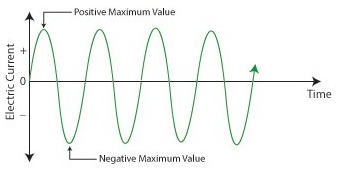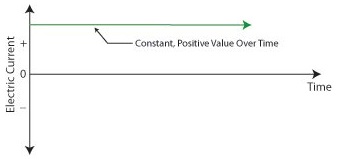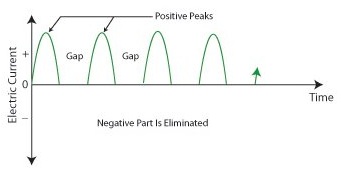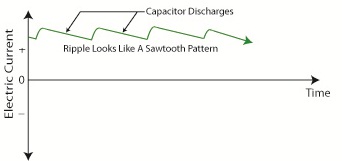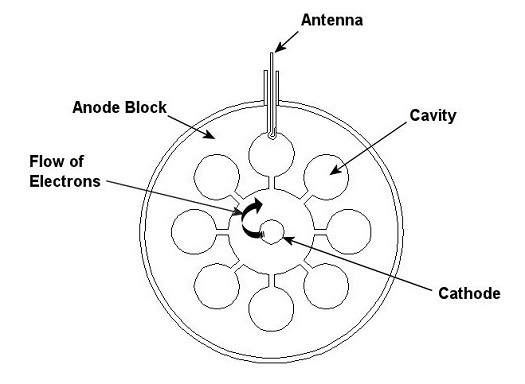| The world of electricity is full of mysteries and often unanticipated outcomes, and if you’ve been reading along with my blog series you have been able to appreciate and come to some understanding of a fair number of them. This week’s installment will be no exception.
Last week we looked briefly at the high voltage circuit within a microwave oven. We discovered that the circuit contains a transformer that raises 120 volts alternating current (AC) to a much higher voltage, around 4000 volts AC. The circuit then transforms the AC into direct current (DC) with the help of electronic components known as a diode and capacitor. Let’s take a closer look at how the diode and capacitor work together to make AC into DC. Let’s follow an AC wave with the aid of a device called an oscilloscope. An oscilloscope takes in an electronic signal, measures it, graphs it, and shows it on a display screen so you can see how the signal changes over time. An AC wave is shown in Figure 1 as it would appear on an oscilloscope. Figure 1 – Alternating Current Wave You can see that each wave cycle starts with a zero value, climbs to a positive maximum value, then back to zero, and finally back down to a maximum negative value. The current keeps alternating between positive and negative polarity, hence the name “alternating current.” Within the microwave oven’s high voltage circuitry the transformer does the job of changing, or transforming if you will, 120 volts AC into 4000 volts AC. This high voltage is needed to make electrons leave the cathode in the magnetron and move them towards the anode to generate microwaves. But we’re not done with the transformation process yet. The magnetron requires DC to operate, not AC. DC current remains constant over time, maintaining a consistent positive value as shown in Figure 2. It is this type of consistency that the magnetron needs to operate. Figure 2 – Direct Current The microwave’s diode and capacitor work together to convert the 4000 volts AC into something which resembles 4000 volts DC. First the diode acts like a one-way valve, passing the flow of positive electric current and blocking the flow of negative current. It effectively chops off the negative part of the AC wave, leaving only positive peaks, as shown in Figure 3. Figure 3 – The Diode Chops Off The Negative Part of the AC Wave Between the peaks are gaps where there is zero current, and this is when the capacitor comes into play. Capacitors are similar to batteries because they can be charged with electrical energy and then discharge that energy when needed. Unlike a battery, the capacitor charges and discharges very quickly, within a fraction of a second. Within the circuitry of a microwave oven the capacitor charges up at the top of each peak in Figure 3, then, when the current drops to zero inside the gaps the capacitor comes into play, discharging its electrical energy into the high voltage circuit. The result is an elimination of the zero current gaps. The capacitor acts as a reserve energy supply to fill in the gaps between the peaks and keep current continually flowing to the magnetron. We have now witnessed a mock DC current situation being created, and the result is shown in Figure 4. Figure 4 – The Capacitor Discharges to Fill In The Gaps Between Peaks The output of this approximated DC current looks like a sawtooth pattern instead of the straight line of a true DC current shown in Figure 2. This ripple pattern is evidence of the “hoax” that has been played with the AC current. The net result is that the modified AC current, thanks to the introduction of the diode and energy storing capacitor, has made an effective enough approximation of DC current to allow our magnetron to get to work jostling electrons loose from the cathode and putting our microwave oven into action. You now have a basic understanding of how to turn AC into an effective approximation of DC current. Next week we’ll find out how this high voltage circuit can prove to be lethal, even when the microwave oven is unplugged. ____________________________________________ |
Posts Tagged ‘cathode’
The Microwave Oven — More on How AC Becomes DC
Monday, August 15th, 2011Microwave Radar and Melted Candy
Sunday, July 24th, 2011| Ever discover a melted candy bar in your pocket? You immediately start to think about the sources for the heat that had caused the mess. Did you stand too close to the stove, were you outside in summer heat too long, or did you simply sit on it? Or was it perhaps caused by being in proximity to a whirring device, something which does not seem to generate any heat at all? If you’ve been reading along with us, you know what device I’m talking about.
Last time we talked about an effect known as cavity resonance and how a sound is created, much like a musical note, when we blow across the top of a glass pop bottle containing some air space. Our breath causes the air molecules to bounce in and out of the bottle’s cavity, producing the sound. Microwave technology works in much the same way, making use of an electronic device called a resonant-cavity magnetron. But instead of generating a musical tone, like our breath does over the bottle, the magnetron produces short wavelength radio waves, known as microwaves, and it was initially developed to generate these microwaves for radar systems. So, how does the magnetron work? The magnetron contains a series of cavities arranged in a circle, their openings pointed towards the center as shown in Figure 1. Engineers determined that when a high voltage, say 4000 volts, is applied to the magnetron, it begins to boil off electrons through a filament, called a cathode, located at its center. Once free of the cathode, the electrons want to flow to a part of the magnetron called the anode. This is because the cathode is positively charged and the anode is negatively charged, and as we know, electrons like to flow from positive to negative. The anode is also the part of the magnetron containing the cavities, and we’ll see the significance of this in a moment. Figure 1 – Interior View of a Resonant-Cavity Magnetron Before the electrons can take their desired straight path to the anode, they are deflected by powerful magnets located on either end of the magnetron. These magnets force the electrons to move in a circular pattern over the openings in the cavities. Like the air molecules passing over the top of a pop bottle when you blow across it, the electrons move over each cavity opening in the magnetron, creating not musical tones, but microwaves. The microwaves are then collected from the magnetron using an antenna and directed along a tube called a wave guide. The microwaves leave the wave guide when they are transmitted by radar systems. The radar system then transmits the microwaves towards moving objects they wish to track. These tracked objects are as diverse as airplanes, ships, and weather patterns. See Figure 2. Figure 2 – Microwave Radar Transmission So, how does the microwave oven fit into our discussion? In 1946 an engineer by the name of Percy Spencer was working on a radar magnetron for the Raytheon Corporation, a producer of electronic technology for industry and defense. During the course of his work he unexpectedly exposed himself to microwaves from a wave guide, and he couldn’t help but notice that the candy bar in his pocket had melted. Putting two plus two together, he realized the microwaves had caused the candy bar to heat up. Dr. Spencer further experimented and came to the conclusion that microwaves can cook foods far more quickly than conventional ovens, and the modern day kitchen appliance was soon born. Next time we’ll look at how Dr. Spencer’s microwave cooking discovery was developed into the microwave oven we find in most kitchens. We’ll also see how even an unplugged microwave oven can pose an electrocution hazard, as I explained in the Discovery Channel program I was recently featured on, Curious and Unusual Deaths. _____________________________________________ |
The Heart of the Microwave Oven
Monday, July 18th, 2011| In the world of inventions it happens with some regularity that an invention to do one thing unexpectedly leads to a device that does something completely different. Take for example Edison’s phonograph. At the time, he was working on an invention to record the dots and dashes of Morse code telegraph messages so they could be sent out repeatedly without an operator having to tap them out each time and possibly making mistakes while doing so. Little did he know that this would lead to the evolvement of the phonograph and recording industries.
Another invention “by mistake” took place when the resonant cavity magnetron, originally developed for use with microwave radar, led to the development of the microwave oven. Last week we talked about how long wave radar, the first type of radar to be developed, was effectively used by the British to repel enemy air attacks during World War II. But long wave radar was large and cumbersome to employ, and it soon evolved into an improved version, the shorter wave, or, as we know it, microwave radar. So what is this resonant cavity magnetron that led to its creation? A pop bottle can give us a clue. Blow across the top of an empty glass pop bottle (or soda bottle, depending on the part of the country you’re from) and a familiar resonant sound results. The sound is created by an effect known as cavity resonance, and other bona fide musical instruments make use of this phenomenon to produce musical sounds. How this works is that where a cavity exists, when air molecules are introduced into it, the molecules are caused to resonate in and out of the cavity many times per second. This creates a sound at a certain frequency, that frequency depending on the shape and dimensions of the cavity, as well as the size of its opening. The resonant cavity magnetron, or magnetron for short, is actually a high powered vacuum tube that operates in a very similar fashion to a pop bottle, or any other musical device making use of a cavity, but instead of using air molecules to generate sound waves, it uses electrons to generate short wavelength radio waves, called microwaves. The magnetron contains a series of cavities that are arranged in a circle with the openings pointing inward towards the center, as shown in Figure 1. Figure 1 – Interior View of a Resonant-Cavity Magnetron Next week we’ll see what this interesting looking device has in common with the simple act of blowing air across the top of a pop bottle and what this all has to do with microwaves. _____________________________________________ |
